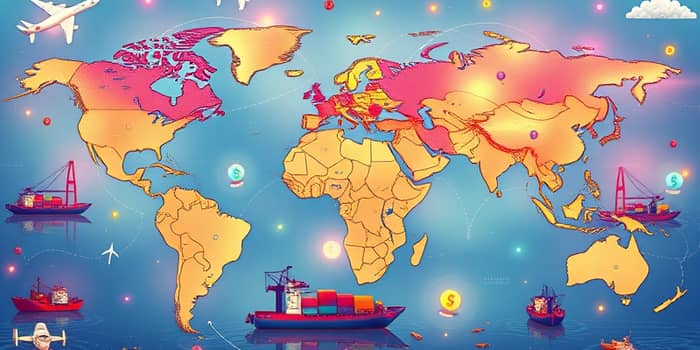The foreign exchange market, or forex, stands as the largest financial market in the world, underpinning the seamless flow of goods, services, and capital across borders. Understanding the mechanisms by which currency values shape trade decisions is essential for businesses, investors, and policymakers alike. This article delves into the inner workings of forex markets and reveals how they drive global commerce.
The Vast Landscape of Forex Markets
Spanning a decentralized, over-the-counter network, the forex market operates 24 hours a day across major financial hubs. Participants include central banks, multinational corporations, institutional investors, and retail traders, all seeking to buy, sell, or hedge currencies.
In April 2022, the market reached a global daily turnover of $7.5 trillion, dwarfing daily global GDP by roughly thirtyfold. The continuous cycle of trades occurs through electronic systems, phone networks, and interbank connections, ensuring deep liquidity and rapid execution.
- London
- New York
- Singapore
- Hong Kong
- Tokyo
Exchange Rates: The Currency of Trade
At the heart of global trade lies currency conversion. Exporters and importers rely on real-time prices to determine transaction costs, profit margins, and competitive positioning.
The forex market establishes precise values through continual bids and offers, influencing the cost of agricultural commodities, industrial machinery, and consumer electronics alike. By representing each transaction in enables cross-border purchase and sale pairs, traders ensure that a Japanese automaker can buy steel in the U.S. or a Brazilian coffee exporter can sell beans in Europe seamlessly.
The Feedback Loop: Trade Balances and Currency Movements
Trade surpluses and deficits feed directly into currency demand. A nation exporting more than it imports often sees increased foreign demand for its currency, reinforcing its value. Conversely, large deficits can exert downward pressure.
Such trade balances and currency movements create a self-reinforcing cycle: stronger currencies can dampen export growth while cheaper currencies boost competitiveness, leading nations to adopt policies that influence monetary flows.
Volatility, Psychology, and Their Trade Impacts
The forex market’s inherent volatility arises not only from economic data but also from market sentiment. Traders often flock to safe haven options — such as the US dollar or Swiss franc — during geopolitical crises or economic uncertainty.
Mindsets like “buy the rumor, sell the fact” can trigger sharp swings around policy announcements. Persistent volatility elevates transaction costs, prompting businesses to include currency clauses in contracts and heightening the demand for risk-mitigation tools.
Economic and Political Drivers of Forex
Exchange rates respond swiftly to macroeconomic indicators, policy shifts, and political events. Key factors include:
- Inflation rates
- Interest rate decisions
- GDP growth figures
- Geopolitical crises
Central bank interventions—through rate changes or direct market operations—can dramatically sway currency values. The Bank of England’s response to Brexit and the Federal Reserve’s rate hikes during inflationary cycles exemplify how policy shapes trade costs.
Strategic Responses: Hedging and Diversification
Businesses and investors deploy a variety of tools to mitigate currency risk. Effective strategies can safeguard profit margins and stabilize cash flows in the face of fluctuating exchange rates.
Among these, derivatives usage for risk hedging has grown significantly. Instruments such as forwards, futures, and options allow firms to lock in rates and protect against adverse moves.
- Forward contracts
- Currency swaps
- Options and futures
- Reserve diversification
Future Outlook: Digital Currencies and Evolving Dynamics
The future of global trade may be reshaped by digital currencies and blockchain-based settlements. Central bank digital currencies (CBDCs) promise faster cross-border payments, potentially reducing dependence on legacy systems.
At the same time, emerging blocs are exploring alternatives to the US dollar, evidenced by the safe haven currencies during uncertainty flight and a gradual tilt toward assets like the yuan. As decentralized finance (DeFi) platforms mature, businesses will gain access to innovative payment rails, further integrating forex with trade finance.
Ultimately, the forex market remains an indispensable engine of globalization. Its real-time pricing, deep liquidity, and strategic significance ensure that currency dynamics continue to shape the destiny of international commerce.
References
- https://www.investopedia.com/articles/forex/11/economic-factors-affecting-forex.asp
- https://www.imf.org/en/News/Articles/2024/05/07/sp-geopolitics-impact-global-trade-and-dollar-gita-gopinath
- https://www.bis.org/publ/qtrpdf/r_qt2212f.htm
- https://www.skydo.com/blog/forex-and-its-impact
- https://www.shareindia.com/knowledge-center/currency-trading/how-the-foreign-exchange-market-facilitates-international-trade
- https://en.wikipedia.org/wiki/Foreign_exchange_market
- https://libertystreeteconomics.newyorkfed.org/2024/01/towards-increasing-complexity-the-evolution-of-the-fx-market/
- https://www.investopedia.com/terms/f/foreign-exchange.asp










